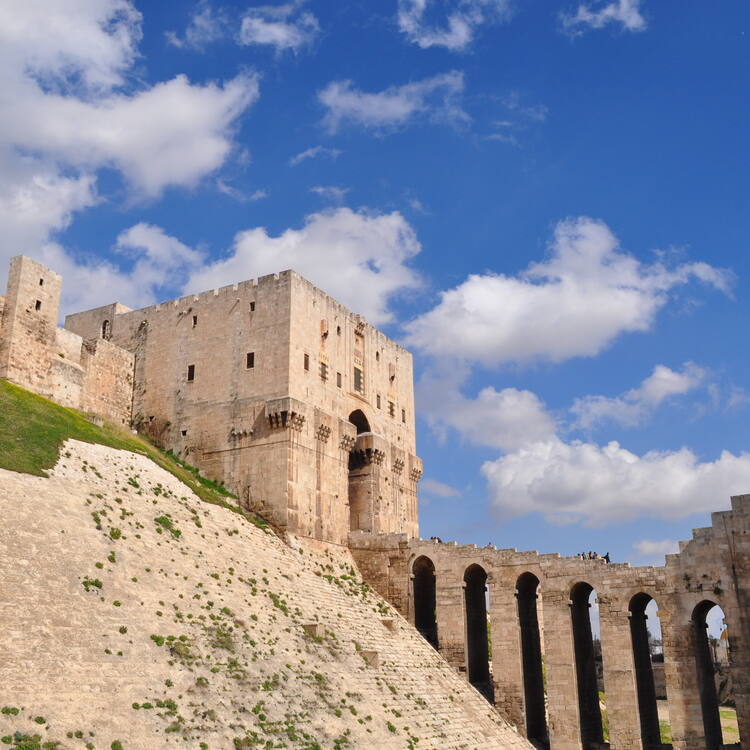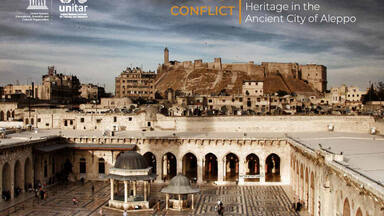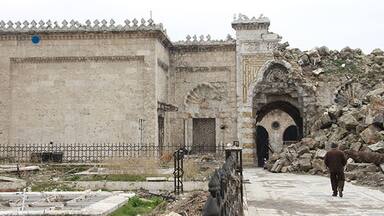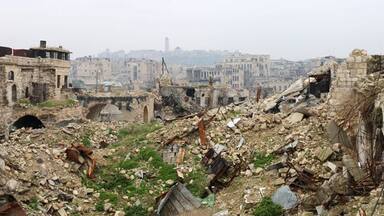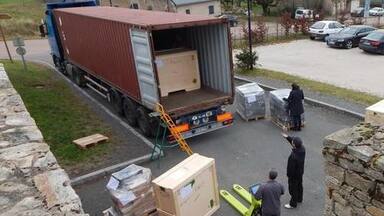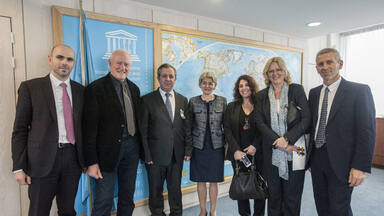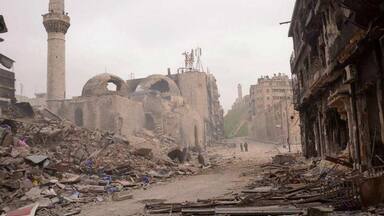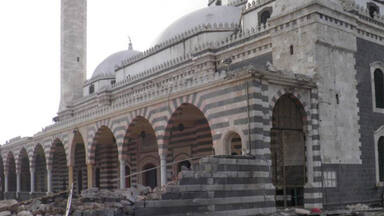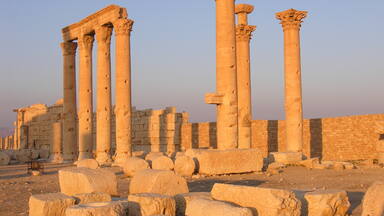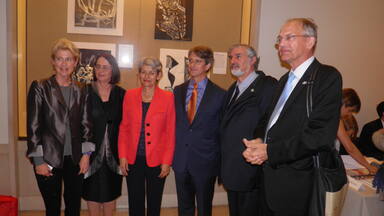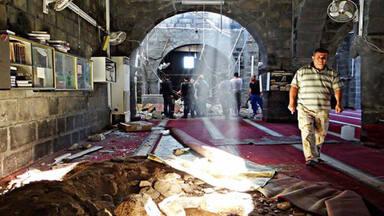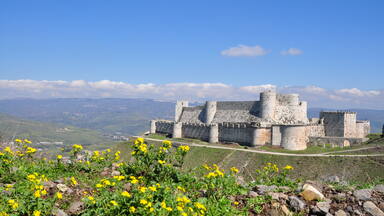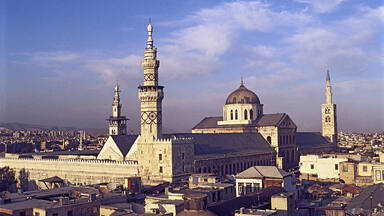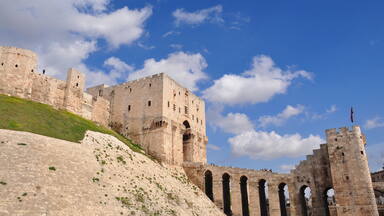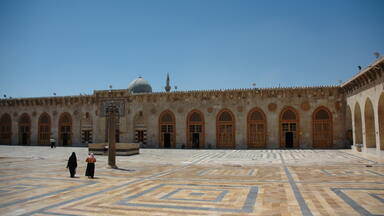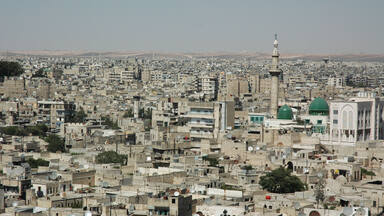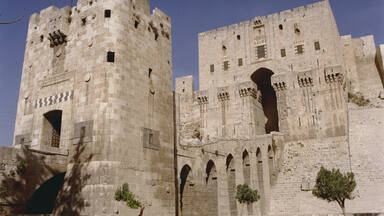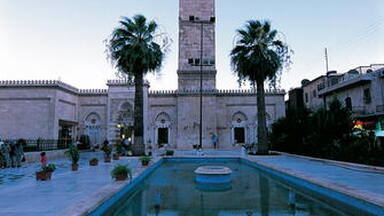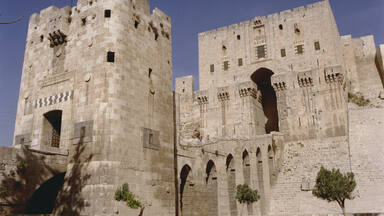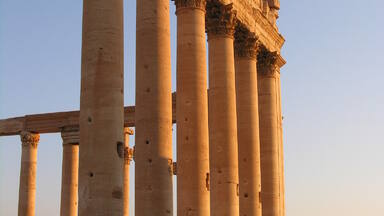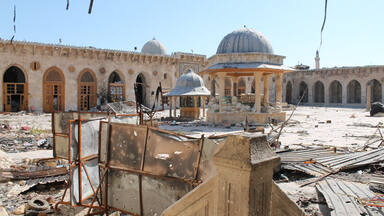Ancient City of Aleppo
Ancient City of Aleppo
Located at the crossroads of several trade routes from the 2nd millennium B.C., Aleppo was ruled successively by the Hittites, Assyrians, Arabs, Mongols, Mamelukes and Ottomans. The 13th-century citadel, 12th-century Great Mosque and various 17th-century madrasas, palaces, caravanserais and hammams all form part of the city's cohesive, unique urban fabric, now threatened by overpopulation.
Description is available under license CC-BY-SA IGO 3.0
Ancienne ville d'Alep
Au carrefour de plusieurs routes commerciales depuis le IIe millénaire av. J.-C., Alep a successivement subi la domination des Hittites, des Assyriens, des Arabes, des Mongols, des Mamelouks et des Ottomans. Sa citadelle du XIIIe siècle, sa Grande Mosquée du XIIe siècle et plusieurs medersa, palais, caravansérails et hammams du XVIIe siècle donnent au tissu urbain d'Alep un caractère harmonieux et unique, maintenant menacé par la surpopulation.
Description is available under license CC-BY-SA IGO 3.0
مدينة حلب القديمة
خضعت حلب على التوالي لسيطرة الحثيين والأشوريين والعرب والمغول والمماليك والعثمانيين لوقوعها على مفترق طرق تجارية متعددة منذ الألفية الثانية قبل الميلاد. فقلعتها التي ترقى الى القرن الثالث عشر ومسجدها الكبير الذي بني في القرن الثاني عشر ومدارسها وقصورها وخانات القوافل وحماماتها المبنية في القرن السابع عشر تضفي على نسيجها المدني طابعاً متناسقاً وفريداً يتهدده اليوم الاكتظاظ السكاني.
source: UNESCO/CPE
Description is available under license CC-BY-SA IGO 3.0
阿勒颇古城
阿勒颇从公元前2000年起就处于几条商道的交汇处,相继由希泰人、亚述人、阿拉伯人、蒙古人、马穆鲁克人和土耳其人统治过。古城内13世纪的城堡、12世纪的大清真寺和17世纪的穆斯林学校、宫殿、沙漠旅店及浴室,构成了城市独特的建筑结构。阿勒颇现今面临人口过盛的困境。
source: UNESCO/CPE
Description is available under license CC-BY-SA IGO 3.0
Старый город в Халебе
Халеб, расположенный на пересечении нескольких торговых путей, начиная со 2-го тысячелетия до н.э. последовательно находился под властью хеттов, ассирийцев, арабов, монголов, мамлюков и турок. Цитадель XIII в., Большая Мечеть XII в., а также разнообразные медресе, дворцы, караван-сараи, бани-«хаммамы» XVII в. составляют часть взаимосвязанной уникальной городской застройки, которой ныне угрожает перенаселенность.
source: UNESCO/CPE
Description is available under license CC-BY-SA IGO 3.0
Ciudad vieja de Alepo
Situada en la encrucijada de varias rutas comerciales desde el segundo milenio antes de nuestra era, Alepo estuvo sucesivamente bajo la dominación de hititas, asirios, árabes, mongoles, mamelucos y otomanos. La gran mezquita del siglo XII, la ciudadela del siglo XIII y sus madrazas, palacios, caravasares y baños de vapor (hammam) del siglo XVII forman parte de un tejido urbano armonioso y único en su género, que hoy en día corre peligro a causa de la superpoblación.
source: UNESCO/CPE
Description is available under license CC-BY-SA IGO 3.0
古都アレッポ
シリア北西部、首都ダマスカスの北約300kmの、世界最古の都市の一つ。肥沃な大地に恵まれ、紀元前2000年前後から地中海とメソポタミアを結ぶ交易中継地、軍事的要衡として栄えてきた。経済上の重要性は今なお衰えておらず、迷路のようなス-ク(市場)、商人たちで賑わったキャラバンサライ(隊商宿)は、イスラーム化の歴史の重層を示してる。この旧都を象徴するアレッポ城は、高さ50mの丘の上にそびえている。source: NFUAJ
Oude stad van Aleppo
Aleppo ligt op het kruispunt van verschillende handelsroutes uit het 2e millennium voor Christus. De stad werd achtereenvolgens geregeerd door de Hittieten, de Assyriërs, de Arabieren, de Mongolen, de Mamelukken en de Ottomanen. Aleppo heeft een samenhangende en uniek stedelijke vorm. De oude stad weerspiegelt de rijke en diverse culturen van de opeenvolgende bewoners. Voorbeelden hiervan in de architectuur zijn te zien in de 13e-eeuwse citadel, de 12e-eeuwse Grote moskee en diverse 17e-eeuwse madrassas, paleizen, karavanserais en hammams. De ommuurde stad rond de citadel toont bewijzen van een vroeg Grieks-Romeins stratenplan.
Source: unesco.nl
Outstanding Universal Value
Brief synthesis
Located at the crossroads of several trade routes since the 2nd millennium B.C., Aleppo was ruled successively by the Hittites, Assyrians, Akkadians, Greeks, Romans, Umayyads, Ayyubids, Mameluks and Ottomans who left their stamp on the city. The Citadel, the 12th-century Great Mosque and various 16th and 17th-centuries madrasas, residences, khans and public baths, all form part of the city's cohesive, unique urban fabric.
The monumental Citadel of Aleppo, rising above the suqs, mosques and madrasas of the old walled city, is testament to Arab military might from the 12th to the 14th centuries. With evidence of past occupation by civilizations dating back to the 10th century B.C., the citadel contains the remains of mosques, palace and bath buildings. The walled city that grew up around the citadel bears evidence of the early Graeco-Roman street layout and contains remnants of 6th century Christian buildings, medieval walls and gates, mosques and madrasas relating to the Ayyubid and Mameluke development of the city, and later mosques and palaces of the Ottoman period. Outside the walls, the Bab al-Faraj quarter to the North-West, the Jdeide area to the north and other areas to the south and west, contemporary with these periods of occupation of the walled city contain important religious buildings and residences. Fundamental changes to parts of the city took place in the 30 years before inscription, including the destruction of buildings, and the development of tall new buildings and widened roads. Nonetheless the surviving ensemble of major buildings as well as the coherence of the urban character of the suqs and residential streets and lanes all contribute to the Outstanding Universal Value.
Criterion (iii): The old city of Aleppo reflects the rich and diverse cultures of its successive occupants. Many periods of history have left their influence in the architectural fabric of the city. Remains of Hittite, Hellenistic, Roman, Byzantine and Ayyubid structures and elements are incorporated in the massive surviving Citadel. The diverse mixture of buildings including the Great Mosque founded under the Umayyads and rebuilt in the 12th century; the 12th century Madrasa Halawiye, which incorporates remains of Aleppo's Christian cathedral, together with other mosques and madrasas, suqs and khans represents an exceptional reflection of the social, cultural and economic aspects of what was once one of the richest cities of all humanity.
Criterion (iv): Aleppo is an outstanding example of an Ayyubid 12th century city with its military fortifications constructed as its focal point following the success of Salah El-Din against the Crusaders. The encircling ditch and defensive wall above a massive, sloping, stone-faced glacis, and the great gateway with its machicolations comprise a major ensemble of military architecture at the height of Arab dominance. Works of the 13th-14th centuries including the great towers and the stone entry bridge reinforce the architectural quality of this ensemble. Surrounding the citadel within the city are numerous mosques from the same period including the Madrasah al Firdows, constructed by Daifa Khatoun in 1235.
Integrity
The boundary of the property follows the line of the walls of the old city and three extra-muros areas: North, Northeast and East suburbs. Some attributes exist beyond the boundary and need protection by a buffer zone.
Although the Citadel still dominates the city, the eight storey hotel development in the Bab al-Faraj area has had a detrimental impact on its visual integrity, as have other interventions before inscription. The remaining coherence of the urban fabric needs to be respected and the vulnerabilities of fabric and archaeological remains, though lack of conservation, need to be addressed on an on-going basis.
Authenticity
Since inscription, the layout of the old city in relation to the dominant Citadel has remained basically unchanged. Conservation efforts within the old city have largely preserved the attributes of the Oustanding Universal Value. However the setting is distinctly vulnerable due to the lack of control mechanisms in the planning administration, including the absence of a buffer zone. The historic and traditional handicraft and commercial activities continue as a vital component of the city sustaining its traditional urban life.
Protection and management requirements
The property is protected by the Antiquities Law administered by the Directorate of Antiquities and Museums (DGAM).
In 1992, the Project for the Rehabilitation of Old Aleppo was set up under the Municipality of Aleppo in cooperation with international agencies. In 1999, the Directorate of the Old City was established under the Municipality of Aleppo to guide the rehabilitation of the old city with three departments covering studies and planning; permits and monitoring, and implementation and maintenance. A comprehensive plan for the evolution of the city is being prepared by the Old City Directorate office. The city's development is being considered under the 'Programme for Sustainable Urban Development in Syria' (UDP), a joint undertaking between international agencies, the Syrian Ministry for Local Administration and Environment, and several other Syrian partner institutions. The programme promotes capacities for sustainable urban management and development at the national and municipal level, and includes further support to the rehabilitation of the Old City.
There is an on-going need to foster traditional approaches to conservation, restoration, repair and maintenance of building fabric. There is also a need for an overall conservation management plan to include planning rules for heights and density of new developments in specific neighbourhoods, and for policies for the protection of archaeological remains uncovered during infrastructure and development works. There is also a need for an approved buffer zone with appropriate planning constraints.
